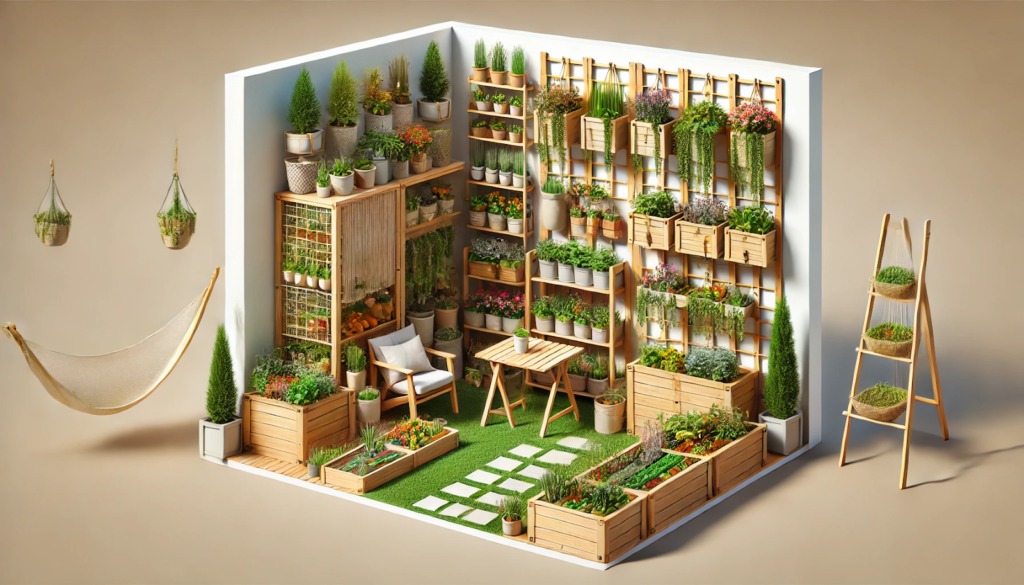Limited space doesn’t mean you can’t have a beautiful, productive garden. With smart planning, vertical elements, and efficient use of every corner, even the smallest outdoor (or indoor) area can become a lush, green retreat.
In this article, you’ll discover practical and creative ideas to maximize small garden spaces—whether you’re working with a balcony, patio, side yard, or compact backyard.
1. Embrace Vertical Gardening
Vertical gardening allows you to grow up instead of out, which is perfect for small spaces.
Ideas:
- Install wall-mounted planters or shelves
- Use trellises for climbing vegetables like peas, beans, and cucumbers
- Hang pots from fences, railings, or pergolas
- Try a living wall with herbs, succulents, or ferns
Vertical gardens add visual height and greenery without using valuable floor space.
2. Use Raised Beds and Tiered Planters
Raised beds help define growing areas and improve soil quality, especially when space is limited.
Benefits:
- Control soil type and drainage
- Keep the garden organized
- Reduce weed growth
- Easier on your back and knees
Tiered planters (or stair-style shelves) allow multiple layers of plants in a small footprint.
3. Choose Compact or Dwarf Plant Varieties
Some plants are naturally better suited for tight spaces.
Great Small-Space Plants:
- Dwarf tomatoes and peppers
- Patio cucumbers
- Baby carrots and beets
- Salad greens and herbs
- Compact blueberry bushes or strawberries in containers
Look for labels that say “bush,” “patio,” or “dwarf” when choosing seeds or seedlings.
4. Incorporate Hanging Baskets
Hanging baskets bring flowers or food crops up into unused airspace.
Ideal for:
- Strawberries
- Cherry tomatoes
- Trailing herbs like thyme or oregano
- Flowers like petunias, nasturtiums, or lobelia
Use strong hooks and rotate baskets for even sun exposure.
5. Optimize Container Gardening
Containers allow flexibility and make it easy to adapt to any space or season.
Container Tips:
- Use fabric grow bags or stackable containers for flexibility
- Group pots by water and light needs
- Choose lightweight materials if moving pots is important
- Include self-watering containers to reduce maintenance
Make sure containers have proper drainage holes to prevent root rot.
6. Create a Foldable or Mobile Garden
Mobility is essential in ultra-small spaces like balconies or decks.
Ideas:
- Use carts or tiered plant stands with wheels
- Install fold-down shelves on walls or railings
- Grow herbs in wall-hung shoe organizers or vertical pockets
These options allow you to rearrange or store your garden as needed.
7. Add Mirrors to Create the Illusion of Space
In tight garden areas, mirrors can reflect light and greenery, making the space feel larger and brighter.
Where to Place:
- Along a fence or wall
- Behind a small seating area
- Facing your most lush planting section
Be sure to use weather-resistant, outdoor-safe mirrors.
8. Mix Function with Style
Your garden can be both beautiful and productive—even in a tiny space.
Blend Features Like:
- A small seating nook surrounded by potted herbs
- A vertical trellis with edible vines and flowering climbers
- A water feature or birdbath integrated into your garden bed
- Decorative gravel or pavers to define walking paths
Choose furniture and decor that complements your space while supporting plant life.
9. Layer Plants by Height and Season
Maximize every inch by designing with staggered plant heights and staggered harvest times.
Layering Example:
- Back: Tall trellised beans or tomatoes
- Middle: Bushy herbs or peppers
- Front: Low leafy greens or edible flowers
This setup provides better airflow, easier access, and aesthetic balance.
10. Use Every Corner and Wall
Look beyond traditional spaces—any vertical surface or tucked-away corner can become garden real estate.
Extra Space Ideas:
- Corner planters
- Wall-mounted gutter gardens
- Hanging mason jars for herbs
- Fence railing planters
Even narrow strips of space can hold a surprising amount of greenery.
Bonus: Smart Storage for Tools and Supplies
In small spaces, storage must be compact and creative.
Storage Solutions:
- Hanging hooks or pegboards for tools
- Hidden storage benches
- Stackable bins for soil or fertilizer
- Vertical sheds or slim cabinets
Keep essentials close at hand but neatly tucked away to avoid clutter.
Final Thoughts: Small Garden, Big Possibilities
A small garden doesn’t have to limit your creativity or productivity. With intentional design, vertical thinking, and efficient use of space, you can grow a vibrant, beautiful garden almost anywhere.
No matter the size of your space, your garden can reflect your lifestyle, feed your body, and nourish your mind. Start with what you have, grow smart, and enjoy the beauty of compact gardening.






